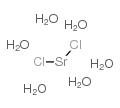| Structure | Name/CAS No. | Articles |
|---|---|---|
 |
Strontium chloride hexahydrate
CAS:10025-70-4 |
|
 |
Strontium chloride
CAS:10476-85-4 |